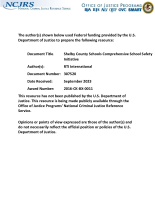Crime prevention
Extreme Risk Protection Orders, Leakage, and Social Networks: The Legislative, Behavioral, and Social Contexts Surrounding Mass Public Shooting Incidents and Plots
Developing a Strategy to Evaluate Urban Violence Prevention and Intervention Ecosystems: A Case Study of Boston
An Examination of the Law Enforcement Role in Implementing Extreme Risk Protection Orders
A 28-year longitudinal study of victimization and perpetration of violence in high-risk youth: Advancing the development of preventive interventions in the community
Understanding and Refining Violence Intervention Implementation: St. Louis (MO) as a Crucial Case
Evaluation of a Healing-Centered Community-Wide Approach to Addressing Firearm Violence in New Orleans
Research & Evaluation of Boston's Community Violence Intervention & Prevention Initiative
Exploring how survivor perspectives and priorities are reflected in the use and implementation of Extreme Risk Protective Orders to address intimate partner violence
Community-Led Learning: A Collaborative Approach to Training and Technical Assistance for Violent Crime Problem Analyses
Perceptions of White-Collar Crime Seriousness: Unpacking and Translating Attitudes into Policy Preferences
He Will Not Leave Us Alone and I Need the Courts to Help": Defendants' Use of Nonphysical Violence in Domestic Violence Protective Order Cases
Shelby County Schools Comprehensive School Safety Initiative
Understanding the Quality and Perceived Impacts of SRO Training: An Evaluation of the Largest National Training Provider for School Police
NIJ FY23 National Study Examining Interpersonal Violence Experienced By Young Adults
Positive Adolescent Interpersonal Relationships (PAIR): A Community-Based STRiV Study
A Frame Analysis of Violence and Accelerationism in Cognitive Radicalization
Extreme Risk Protection Orders in Washington State and their Impact on Firearm-Related Arrests and Convictions
What Works to Reduce Violent Gun Crime in Focused Deterrence Initiatives? Estimating the Effect of Services and Enforcement in Facilitating Desistence Among Prolific Violent Offenders
Secretariat for ISO/IEC JTC 1/SC 37, Biometrics
Life-course and Intergenerational Effects of Crime and Criminal Justice Involvement: Identifying Risks and the Search for Resilience
Domestic Terrorism Targeting America’s Political Elites
De-escalation Training: What Works, Implementation Lessons, and Taking It to Scale; Plenary at the 2023 NIJ Research Conference
Police use of force, while infrequently used, is a tremendous concern to public safety in the United States when officers employ it excessively or inappropriately, causing injury or death and eroding public trust in law enforcement. This plenary from the 2023 NIJ Research Conference describes the Integrating, Communications, Assessment, and Tactics (ICAT) de-escalation training program developed by the Police Executive Research Forum to guide officers in defusing critical incidents.
See the YouTube Terms of Service and Google Privacy Policy



